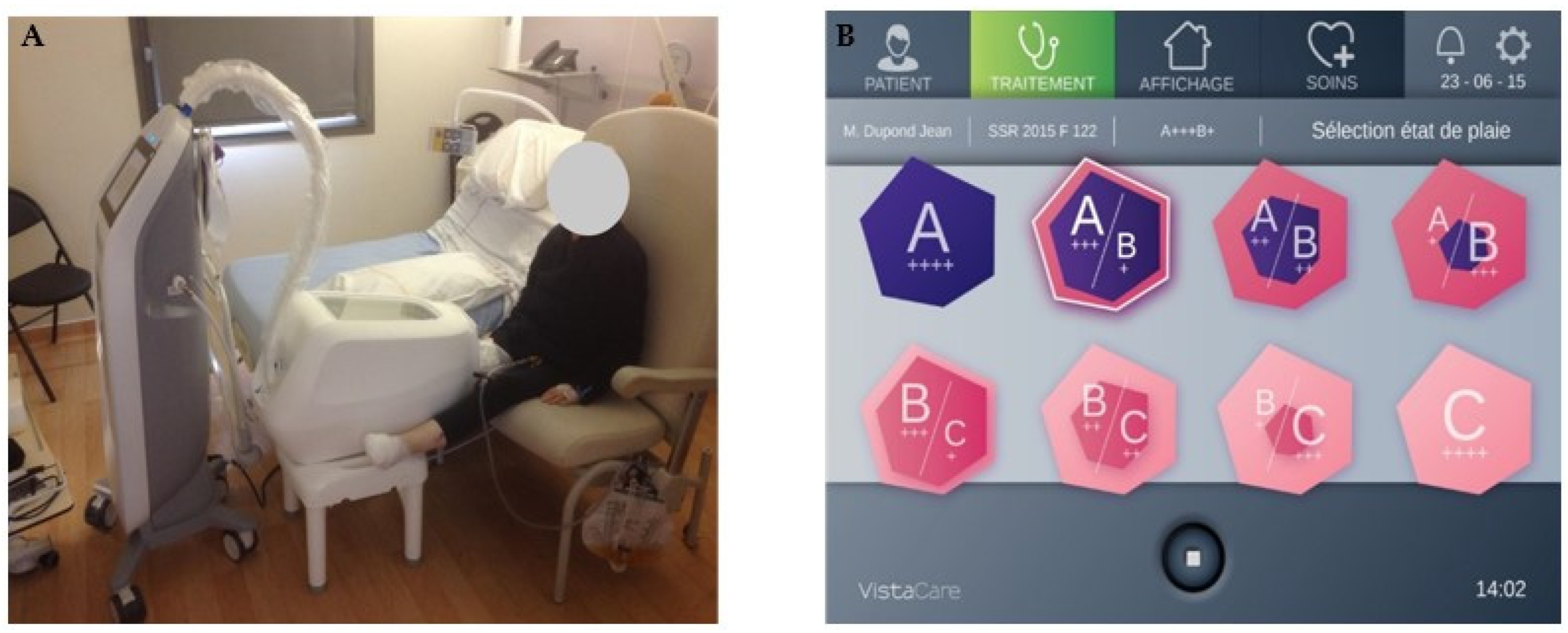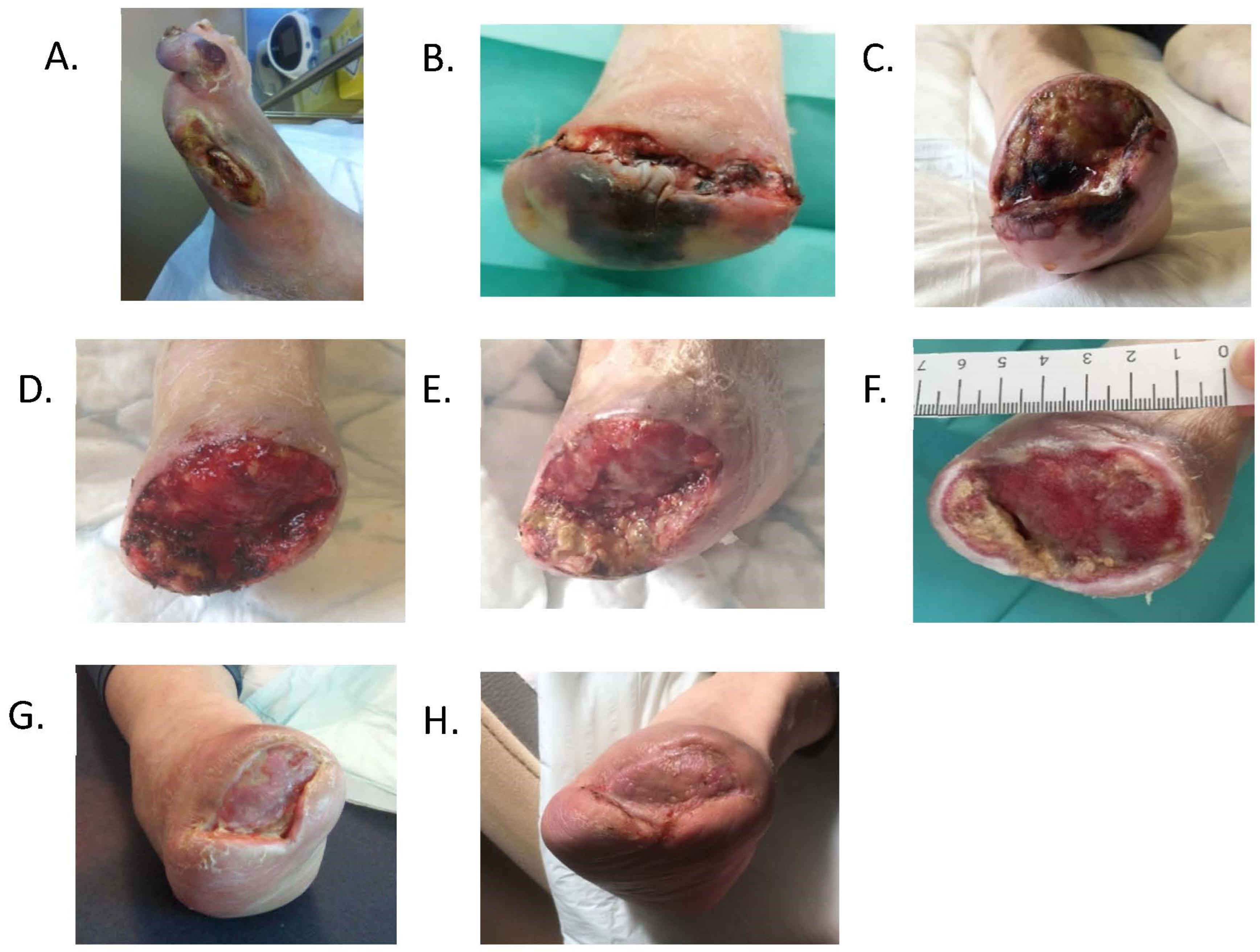A Wound Environment Control System to Avoid Major Amputation in Diabetic Foot Ulcers
Abstract
1. Introduction
2. Case Presentation
3. Conclusions
Author Contributions
Funding
Institutional Review Board Statement
Informed Consent Statement
Data Availability Statement
Acknowledgments
Conflicts of Interest
References
- Armstrong, D.G.; Boulton, A.J.; Bus, S.A. Diabetic foot ulcers and their recurrence. N. Engl. J. Med. 2017, 376, 2367–2375. [Google Scholar] [CrossRef]
- Winter, G.D. Formation of the Scab and the Rate of Epithelization of Superficial Wounds in the Skin of the Young Domestic Pig. Nature 1962, 193, 293–294. [Google Scholar] [CrossRef] [PubMed]
- Lübbers, D.W. Microcirculation and O2 Exchange through the Skin Surface: A Theoretical Analysis. In Oxygen Transport to Tissue XVI; Hogan, M.C., Mathieu-Costello, O., Poole, D.C., Wagner, P.D., Eds.; Springer: Boston, MA, USA, 1994; pp. 51–58. [Google Scholar]
- Xia, Z.; Sato, A.; Hughes, M.A.; Cherry, G.W. Stimulation of fibroblast growth in vitro by intermittent radiant warming. Wound Repair Regen. 2000, 8, 138–144. [Google Scholar] [CrossRef] [PubMed]
- Frykberg, R.G.; Franks, P.J.; Edmonds, M.; Brantley, J.N.; Téot, L.; Wild, T.; Garoufalis, M.G.; Lee, A.M.; Thompson, J.A.; Reach, G.; et al. A Multinational, Multicenter, Randomized, Double-Blinded, Placebo-Controlled Trial to Evaluate the Efficacy of Cyclical Topical Wound Oxygen (TWO2) Therapy in the Treatment of Chronic Diabetic Foot Ulcers: The TWO2 Study. Diabetes Care 2020, 43, 616–624. [Google Scholar] [CrossRef]
- Monteiro-Soares, M.; Russell, D.; Boyko, E.J.; Jeffcoate, W.; Mills, J.L.; Morbach, S.; Game, F.; International Working Group on the Diabetic Foot (IWGDF). Guidelines on the classification of diabetic foot ulcers (IWGDF 2019). Diabetes Metab. Res. Rev. 2020, 36 (Suppl. 1), e3273. [Google Scholar] [CrossRef]


Disclaimer/Publisher’s Note: The statements, opinions and data contained in all publications are solely those of the individual author(s) and contributor(s) and not of MDPI and/or the editor(s). MDPI and/or the editor(s) disclaim responsibility for any injury to people or property resulting from any ideas, methods, instructions or products referred to in the content. |
© 2023 by the authors. Licensee MDPI, Basel, Switzerland. This article is an open access article distributed under the terms and conditions of the Creative Commons Attribution (CC BY) license (https://creativecommons.org/licenses/by/4.0/).
Share and Cite
Vouillarmet, J.; Fribourg, G.; Labaisse, L.; Della-schiava, N. A Wound Environment Control System to Avoid Major Amputation in Diabetic Foot Ulcers. Medicina 2023, 59, 430. https://doi.org/10.3390/medicina59030430
Vouillarmet J, Fribourg G, Labaisse L, Della-schiava N. A Wound Environment Control System to Avoid Major Amputation in Diabetic Foot Ulcers. Medicina. 2023; 59(3):430. https://doi.org/10.3390/medicina59030430
Chicago/Turabian StyleVouillarmet, Julien, Gisele Fribourg, Lauriane Labaisse, and Nellie Della-schiava. 2023. "A Wound Environment Control System to Avoid Major Amputation in Diabetic Foot Ulcers" Medicina 59, no. 3: 430. https://doi.org/10.3390/medicina59030430
APA StyleVouillarmet, J., Fribourg, G., Labaisse, L., & Della-schiava, N. (2023). A Wound Environment Control System to Avoid Major Amputation in Diabetic Foot Ulcers. Medicina, 59(3), 430. https://doi.org/10.3390/medicina59030430




